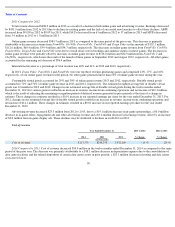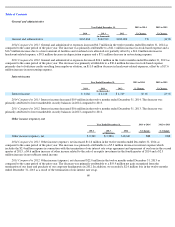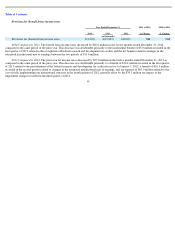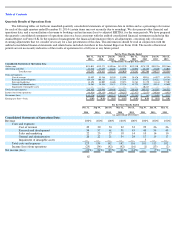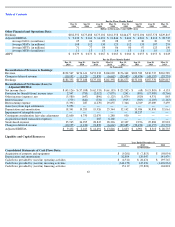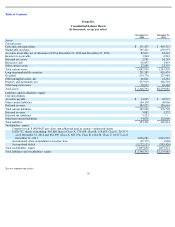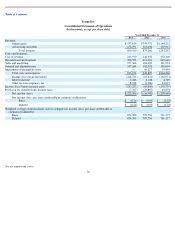Zynga 2014 Annual Report Download - page 70
Download and view the complete annual report
Please find page 70 of the 2014 Zynga annual report below. You can navigate through the pages in the report by either clicking on the pages listed below, or by using the keyword search tool below to find specific information within the annual report.
Table of Contents
various widely accepted payment methods offered in the games, including PayPal, Apple iTunes accounts, Google Wallet, credit cards and direct
wires. We also sell existing inventory of game cards that are initially recorded as a customer deposit liability which is included in other current
liabilities on the consolidated balance sheet, net of fees retained by retailers and distributors. Upon redemption of a game card in one of our
games and delivery of the purchased virtual currency to the player, these amounts are reclassified to deferred revenue. Advance payments from
customers that are non-refundable and relate to non-cancellable contracts that specify our obligations are recorded to deferred revenue. All other
advance payments that do not meet these criteria are recorded as customer deposits.
We recognize revenue when all of the following conditions are satisfied: there is persuasive evidence of an arrangement; the service has
been provided to the player; the collection of our fees is reasonably assured; and the amount of fees to be paid by the player is fixed or
determinable. For purposes of determining when the service has been provided to the player, we have determined that an implied obligation
exists to the paying player to continue displaying the purchased virtual goods within the online game over their estimated life or until they are
consumed. Accordingly, we categorize our virtual goods as either consumable or durable. The proceeds from the sale of virtual goods are
initially recorded in deferred revenue. Consumable virtual goods represent goods that can be consumed by a specific player action. Common
characteristics of consumable goods may include virtual goods that are no longer displayed on the player’s game board after a short period of
time, do not provide the player any continuing benefit following consumption or often times enable a player to perform an in-game action
immediately. For the sale of consumable virtual goods, we recognize revenue as the goods are consumed, which approximates one month.
Durable virtual goods represent virtual goods that are accessible to the player over an extended period of time. We recognize revenue from the
sale of durable virtual goods ratably over the estimated average playing period of paying players for the applicable game, which represents our
best estimate of the average life of durable virtual goods. If we do not have the ability to differentiate revenue attributable to durable virtual
goods from consumable virtual goods for a specific game we recognize revenue on the sale of durable and consumable virtual goods for that
game ratably over the estimated average period that paying players typically play that game.
Prior to October 1, 2009, we did not have the data to determine the consumption dates for our consumable virtual goods or to differentiate
revenue attributable to durable virtual goods from consumable virtual goods. Beginning in October 2009, we had sufficient data to separately
account for consumable and durable virtual goods in one of our games, thus allowing us to recognize revenue related to consumable goods upon
consumption. Since January 2010, we have had this data for substantially all of our web games, thus allowing us to recognize revenue related to
consumable goods upon consumption for our web-based games. However, for our standalone mobile games, we do not have the requisite data to
separately account for consumable and durable virtual goods and have therefore recorded mobile revenue ratably over the estimated average
payer life. We expect that in future periods there will be changes in the mix of durable and consumable virtual goods sold, reduced virtual good
sales in some existing games, changes in estimates in average paying payer life and/or changes in our ability to make such estimates. When such
changes occur, and in particular if more of our revenue in any period is derived from goods for which revenue is recognized over the estimated
average playing period, or that period increases on average, the amount of revenue that we recognize in a future period may be reduced, perhaps
significantly.
On a quarterly basis, we determine the estimated average playing period for paying players by game beginning at the time of a payer’
s first
purchase in that game and ending on a date when that paying player is no longer playing the game. To determine when paying players are no
longer playing a given game, we analyze monthly cohorts of paying players for that game who made their first in-
game payment between six and
18 months prior to the beginning of each quarter and determine whether each player within the cohort is an active or inactive player as of the
date of our analysis. To determine which players are inactive, we analyze the dates that each paying player last logged into that game. We
determine a paying player to be inactive once they have reached a period of inactivity for which it is probable (defined as at least 80%) that a
player will not return to a specific game. For the payers deemed inactive as of our analysis date we analyze the dates they last logged into
67



